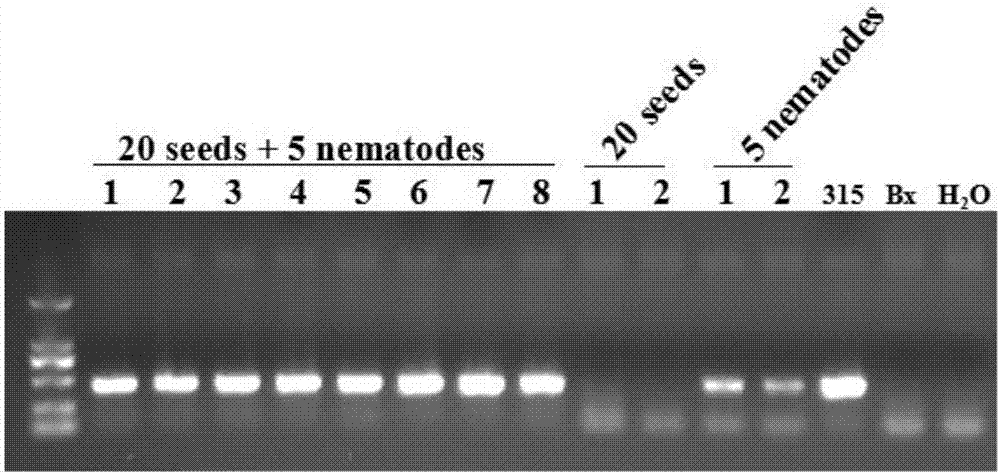Primer for detecting aphelenchoides besseyi in rice seeds and seedlings and application thereof
A technology for rice nematodes and nematodes, which is applied in the field of molecular biology, can solve the problems of shortening detection time, long time consumption, etc., and achieves the effects of high sensitivity and fast detection speed.
- Summary
- Abstract
- Description
- Claims
- Application Information
AI Technical Summary
Problems solved by technology
Method used
Image
Examples
Embodiment 1
[0029] The design of embodiment 1 rice stem sharp nematode specific primer
[0030] Reference ITS sequence for primer design: 6 other species (Aphelenchoides besseyi, KJ009342, EU186069, JF826517, JF826518, JF826519, JF932290, KP757371, KP757372, KP757373) of the same genus (Aphelenchoides besseyi, KJ009342, KP757373) and other 6 species (Aphelenchoides 1, Aphelenia 9choides 1, 1 菊花滑刃线虫(Aphelen choides ritzemabosi,EU186068),花生滑刃线虫(Aphelenchoides arachidis,KC771278),Aphelenchoides paradalianensis(HQ454505),Aphelenchoidesbicaudatus(GU984233),Aphelenchoides subtenuis(EF213109)的线虫和同科的松材线虫(Bursaphelenchus xylophilus, KP644770).
[0031] The software used in this experiment is the Primer designing tool of NCBI, and the DNA sequence used is the KJ009342 sequence of the rice stem nematode, which consists of part of the 18S rDNA sequence, ITS1, 5.8S rDNA sequence, ITS2, and part of the 28S rDNA sequence. .
[0032] Both the forward and reverse primers of the present invention can comp...
Embodiment 2
[0033] The detection of the dry sharp nematode of embodiment 2 mass culture
[0034] Extraction of a large amount of nematode DNA:
[0035] F8 (Liaoning japonica rice), Ningjing48 (Ningxia japonica rice), cy44 (Jiangsu japonica rice), Mianzhu (Sichuan indica rice) were selected as nematode strains, with 3 replicates for each line.
[0036] 1) Collect 100 μL of mass-cultured A. sativa in a 2 mL centrifuge tube;
[0037] 2) After quick-freezing in liquid nitrogen, add 700 μL of DNA extraction buffer, mix well, add 5 μL of 20 mg / mL proteinase K, and mix well;
[0038] 3) In a water bath at 55°C for 30 minutes, add an equal volume of phenol / chloroform / isoamyl alcohol (25:24:1) extract and mix well;
[0039] 4) Centrifuge at 12000rpm for 10min at room temperature, and take the supernatant into a new 1.5mL centrifuge tube;
[0040] 5) Add 0.8 times the volume of frozen isopropanol and 0.1 times the volume of 3M sodium acetate (pH5.2), and mix well;
[0041] 6) After standing at ...
Embodiment 3
[0052] The detection of embodiment 3 single stem sharp nematodes
[0053] Extraction of single nematode DNA:
[0054] F8 (Liaoning japonica), Ningjing48 (Ningxia japonica), cy44 (Jiangsu japonica) and Mianzhu (Sichuan indica) were selected as nematode strains, with 5 replicates for each line. The method refers to the single nematode DNA extraction method of Wang Jiangling et al. (2011).
[0055] a. Pick a single nematode and add 8μL ddH 2 O and 1 μL of 10×PCR Buffer (Mg2+free) in a PCR tube;
[0056] b. Quickly freeze in liquid nitrogen for 1 minute, then heat at 85°C for 2 minutes;
[0057] c. Add 1 μL 20mg / mL proteinase K to the PCR tube;
[0058] d. Heat at 56°C for 15 minutes and at 95°C for 10 minutes; the obtained DNA extract can be directly used for PCR amplification.
[0059] PCR amplification of D. elegans DNA:
[0060] PCR system: same as PCR to amplify single-headed nematode DNA. PCR amplification program: 94°C, 4min; 94°C for 30s, 55-60°C for 30s, 72°C for 4...
PUM
 Login to View More
Login to View More Abstract
Description
Claims
Application Information
 Login to View More
Login to View More - R&D
- Intellectual Property
- Life Sciences
- Materials
- Tech Scout
- Unparalleled Data Quality
- Higher Quality Content
- 60% Fewer Hallucinations
Browse by: Latest US Patents, China's latest patents, Technical Efficacy Thesaurus, Application Domain, Technology Topic, Popular Technical Reports.
© 2025 PatSnap. All rights reserved.Legal|Privacy policy|Modern Slavery Act Transparency Statement|Sitemap|About US| Contact US: help@patsnap.com



